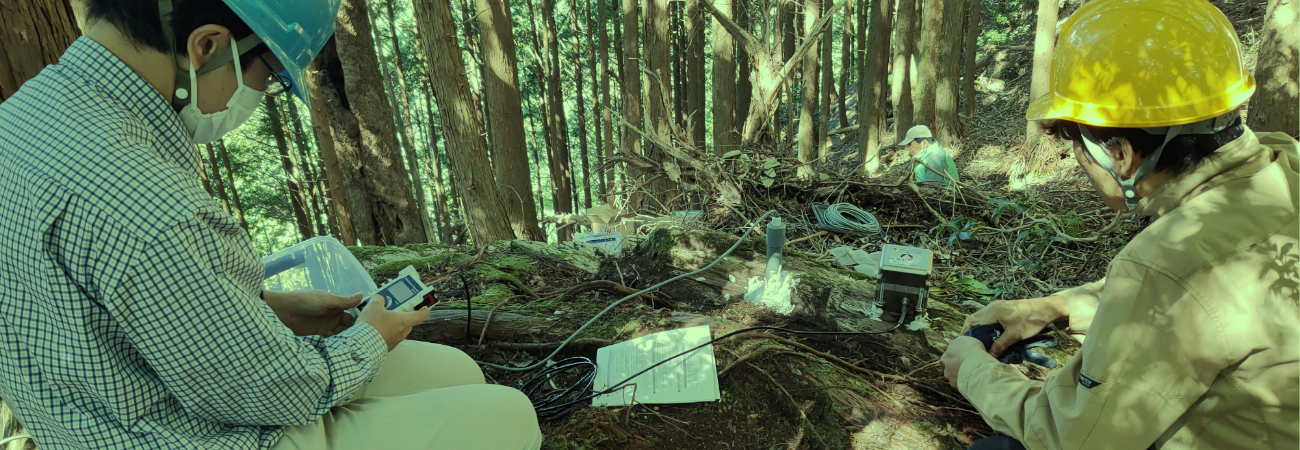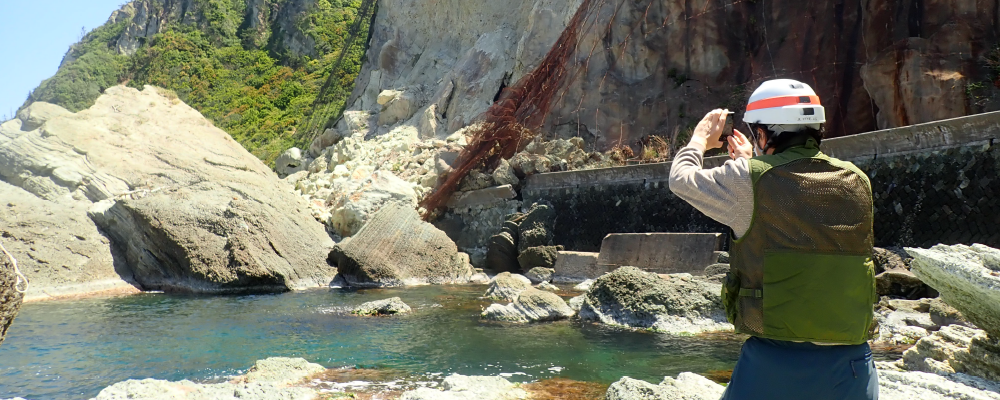
Homepage : https://seisimager.com/
Researchmap : https://researchmap.jp/koichi-hayashi
ResearchGate : https://www.researchgate.net/profile/Koichi-Hayashi-2
Linked in : https://www.linkedin.com/in/koichi-hayashi-4969a537/
物理探査技術者として33年以上にわたって、より良い調査手法や解析アルゴリズムを土木・環境分野の地盤調査に提供するよう働いてます。千葉大学理学部地学科を1990年に卒業後、応用地質に入社しました。その後、1999年にマサチューセッツ工科大学の地球科学分野で修士、2008年に京都大学の工学研究科で博士を取得しました。2010年に渡米して応用地質の子会社のGeometrics社で主に測定器や解析ソフトウェアの開発に従事しました。2024年から京都大学防災研究所に勤務しています。主な研究分野は、屈折法地震探査、表面波探査、微動アレイ探査、差分法による波動場シミュレーション、光ファイバを用いた振動計測(DAS)、機械学習などです。これらの開発した解析アルゴリズムを、屈折法地震探査、表面波探査、微動アレイ探査、PS検層など解析プログラムにまとめてSeisImagerとして提供し、多くの技術者に使ってもらっています。物理探査学会、米国物理探査学会(SEG)、米国土木環境分野物理探査学会、ヨーロッパ物理探査学会、アメリカ地震学会などに所属し定期的に発表しています。2014年にはアメリカ物理探査学会においてHonorary Lecturerに選ばれ、「Integrated Geophysical Methods Applied to Geotechnical and Geohazard Engineering: From Qualitative to Quantitative Analysis and Interpretation」というタイトルで講演を行いました。最近では「Seismic Ambient Noise」の共著や、アメリカ物理探査学会のトレーニングコースで「Passive Surface Wave Methods Using Ambient Noise: from Basic 1D Soundings to High-resolution 3D Imaging」を担当しています。
Over the past 33 years, I have worked as a research geophysicist focusing on providing better tools and algorithms for near-surface geophysical methods. I earned a B.S. degree in Earth Sciences from Chiba University in Japan and joined OYO Corporation in 1990. While working at OYO Corporation, I earned a M.S. degree in Earth Sciences from the Massachusetts Institute of Technology in 1999, and a Ph.D. in Earth Resources Engineering from Kyoto University in Japan in 2008. In 2010 I moved to U.S. and worked for Geometrics that is a subsidiary of OYO. In 2024, I left OYO group and joined Kyoto University. My main research areas are seismic refraction, active and passive surface waves, finite-difference seismic modeling, distributed acoustic sensing, and machine learning. I am the author of the SeisImager data analysis suite of programs and has incorporated many of my theoretical developments into the software, making SeisImager one of the premier active and passive surface waves, refraction, and downhole data processing packages available today. I regularly present papers at the major meetings, publishes in journals of SEG, SEGJ, EEGS, EAGE and SSA, and serves on scientific commissions. In 2014, I was selected as the SEG Near-Surface Honorary Lecturer, with my talk entitled “Integrated Geophysical Methods Applied to Geotechnical and Geohazard Engineering: From Qualitative to Quantitative Analysis and Interpretation”. Most recently, I was a contributing author to the textbook entitled “Seismic Ambient Noise”. I am currently in charge of a lecturer for a SEG training course “Passive Surface Wave Methods Using Ambient Noise: from Basic 1D Soundings to High-resolution 3D Imaging”.
Researchmap : https://researchmap.jp/makoto.matsuzawa
京都大学の修士課程を修了後、2007年に建設コンサルタント会社であるパシフィックコンサルタンツ(株)に入社しました。技術者として土砂災害関連の業務に携わり、業務を行いながら社会人博士課程で和泉層群砂岩の風化に関する研究を行い、2020年に博士号を取得しました。2021年からは(公財)深田地質研究所に異動し、引き続き、土砂災害関連の研究に携わり、2024年から斜面未災学研究センターに着任しました。
現在、土砂災害の発生メカニズムの検討、崩壊危険箇度マップの作成、住民参加型の土砂災害ハザードマップの作成、一般住民の防災教育などの研究をしています。技術者としての経験を活かして土砂災害に関する研究成果の社会実装、防災教育を進めていきたいと考えています。
My main research topics are
1) Mechanism of landslide disaster
2) Landslide risk assessment map
3) Landslide hazard map with the participation of local residents
4) Disaster prevention education for local residents
Homepage:https://landslide.dpri.kyoto-u.ac.jp/docs/WangGH-HP/wanggh.htm
Researchmap: https://researchmap.jp/read0201182
現地調査や観測,室内外土質実験および理論解析などを通じて,地すべりの発生・運動機構に関する基礎研究を実施し,斜面災害予測研究を進めている.主に,「地震や降雨時における高速・長距離運動地すべりの発生・運動機構」,「地すべり土塊運動予測の高度化」,「粒状体のせん断挙動」,「大規模再活動型地すべりの危険度評価と被害軽減化対策」,「天然ダムの形成・決壊危険度評価および災害軽減対策」,「異常気象時の斜面変動機構と運動予測」等に焦点をあてて研究を行っています.
Through field investigations, monitoring, indoor and outdoor geophysical and geotechnical experiments, and theoretical analyses, he has been conducting fundamental research on the initiation and movement mechanisms of landslides, advancing studies in landslide prediction. His research primarily focuses on “the initiation and movement mechanisms of rapid long-traveling landsliding phenomena during earthquakes and/or heavy rainfall,” “prediction of displaced landslide materials”, “shear behavior of granular materials”, “risk assessment and mitigation measures for large-scale reactivated landslides”, “Formation and collapse risk of landslide dam, and disaster mitigation”, and “Landsliding behavior and prediction under abnormal weather conditions”, etc.
Researchmap: https://researchmap.jp/read0151421
斜面において地震動などの観測をおこない、データの詳細な解析を実施することによって、地震時地すべりがどのようにして発生するかについて調べています。北海道から九州のさまざまな形態の斜面がフィールドです。また、地震学的な知見や手法を斜面現象に適用し、降雨などによる地すべりのモニタリングや発生場の理解に関する研究も進めています。斜面現象と地震学を融合させた新学問分野である斜面地震学の確立を目指しています。
How coseismic landslides are generated is investigated by means of field observation and data analysis. Our monitoring fields range from Hokkaido to Kyushu in Japan. By applying seismological knowledge and methods to landslides, researches on monitoring rain-induced landslides and understanding landslide generation fields are conducted. I am trying to establish a new study field “Slope Seismology” where landslide phenomena and seismology are integrated.
(附属)徳島地すべり観測所勤務
Researchmap:https://researchmap.jp/yamasakis
私の研究室では地質学を基礎に、電子顕微鏡レベルの物性の研究,各種物理探査、動態観測、レーザーマッピング、UAV(無人航空機)、衛星測位システムを使った観測などの様々な手段を用いて複雑で多様な現象である地すべりを研究します。さらに、斜面災害の関わる技術者・学生のために、応用地質学の教育・支援活動を行っています。私は日本有数の地すべり地である四国山地入り口に位置する徳島地すべり観測所を拠点にしていますが、フィールドは海底や極北グリーンランドにも広がっています。私のこれまでの研究に関してはResearchmapをご覧下さい。
In our laboratory, based on geological principles, we study landslides, complex and diverse phenomena, using various methods, including research at the electron microscope level, various physical explorations, field observation, UAV, laser mapping, and observations using satellite positioning systems.Furthermore, for engineers and students involved in slope disasters, we conduct educational and support activities in engineering geology. I am based at the Tokushima Landslide Observation Station, situated at the entrance of the Shikoku Mountains, one of the most prominent landslide areas in Japan.
However, our research extends to the seabed and the far north of Greenland. For more information about my past research, please refer to Researchmap.
(附属)徳島地すべり観測所勤務
Researchmap:https://researchmap.jp/m-nkym
2025年4月から斜面未災学研究センターに着任しました。フィールド観測や室内実験を通して、降雨や地震を誘因とする地すべり発生時などにおいて斜面内部でどのようなことが生じているのかを明らかにするための研究に取り組んでいます。さらに、地震時における斜面の応答特性変化や斜面のような不均質の強い媒質中の地震波伝播特性を調べる研究も進めています。
I investigate what happens inside slopes while landslides occur due to rainfall or earthquakes through field observations and laboratory experiments. I am also trying to understand the temporal variations in the seismic response of slopes and the propagation characteristics of elastic waves transmitted through strongly heterogeneous media such as slopes.
(附属)徳島地すべり観測所勤務
Researchmap:https://researchmap.jp/geo357
付加体からなる山地で豪雨や地震等に伴い発生する大規模崩壊の発生場と発生メカニズムに関する研究を行っています。具体例として、1889年と2011 年に紀伊山地で豪雨により発生した事例、1857 年に四国山地で安政安芸伊予地震等により発生したトウジ山の事例、2005年に九州山地東部で豪雨により発生した事例等があります。大規模崩壊による被害を減らすためには、発生場所を予測し事前に避難することが重要です。研究手法として、応用地質学をベースとして地形学、地震学、地盤工学(土質力学,岩盤力学,水理学等)手法を取り入れながら,フィールド調査や観測、地形地質データのGIS 解析等を行っています。メインのフィールドは、西南日本外帯に広がる山地で東は静岡県から西は宮崎県までを対象としています。
My main target is deep-seated catastrophic landslides (DCLs) induced by heavy rainfall and earthquakes in mountains underlain by accretional complexes. Instances are DCLs that occurred in the Kii Mountains in 1889 and 2011 by heavy rain, Toujiyama DCLs that occurred in the Shikoku Mountains in 1857 by the Ansei-Aki-Iyo earthquake, and DCLs that occurred in Kyushu Mountains in 2005 by heavy rain. The most important issues are predicting the potential slopes for DCLs and evacuation. To clarify the geological and geomorphological causes and initiation mechanisms of DCLs, geological surveys, seismic observations of slopes and GIS analysis are performed using applied geology, geomorphology, seismology and geotechnical engineering. The main fields are mountains in the outer zone of Southwest Japan.
